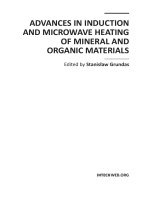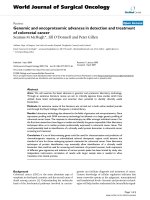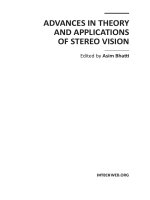Oxford american handbook of cardiology
Bạn đang xem bản rút gọn của tài liệu. Xem và tải ngay bản đầy đủ của tài liệu tại đây (4.04 MB, 706 trang )
Oxford American Handbook of
Cardiology
About the Oxford American Handbooks in Medicine
The Oxford American Handbooks are pocket clinical books, providing
practical guidance in quick reference, note form. Titles cover major medical specialties or cross-specialty topics and are aimed at students, residents, internists,
family physicians, and practicing physicians within specific disciplines.
Their reputation is built on including the best clinical information, complemented by hints, tips, and advice from the authors. Each one is carefully
reviewed by senior subject experts, residents, and students to ensure that
content reflects the reality of day-to-day medical practice.
Key series features
• Written in short chunks, each topic is covered in a two-page spread
to enable readers to find information quickly. They are also perfect
for test preparation and gaining a quick overview of a subject without
scanning through unnecessary pages.
• Content is evidence based and complemented by the expertise and
judgment of experienced authors.
• The Handbooks provide a humanistic approach to medicine – it’s
more than just treatment by numbers.
• A “friend in your pocket,” the Handbooks offer honest, reliable
guidance about the difficulties of practicing medicine and provide
coverage of both the practice and art of medicine.
• For quick reference, useful “everyday” information is included on the
inside covers.
Published and Forthcoming Oxford American Handbooks
Oxford American Handbook of Clinical Medicine
Oxford American Handbook of Anesthesiology
Oxford American Handbook of Cardiology
Oxford American Handbook of Clinical Dentistry
Oxford American Handbook of Clinical Diagnosis
Oxford American Handbook of Clinical Pharmacy
Oxford American Handbook of Critical Care
Oxford American Handbook of Emergency Medicine
Oxford American Handbook of Geriatric Medicine
Oxford American Handbook of Nephrology and Hypertension
Oxford American Handbook of Neurology
Oxford American Handbook of Obstetrics and Gynecology
Oxford American Handbook of Oncology
Oxford American Handbook of Otolaryngology
Oxford American Handbook of Pediatrics
Oxford American Handbook of Physical Medicine and Rehabilitation
Oxford American Handbook of Psychiatry
Oxford American Handbook of Pulmonary Medicine
Oxford American Handbook of Rheumatology
Oxford American Handbook of Sports Medicine
Oxford American Handbook of Surgery
Oxford American Handbook of Urology
Oxford American
Handbook of
Cardiology
Edited by
Jeffrey R. Bender, MD
Robert I. Levy Professor of Preventive Cardiology
Associate Chief, Cardiovascular Medicine
Yale University School of Medicine
New Haven, Connecticut
Kerry S. Russell, MD, PhD
Associate Professor of Cardiovascular Medicine
Yale University School of Medicine
New Haven, Connecticut
Lynda E. Rosenfeld, MD
Associate Professor of Medicine and Pediatrics
Section of Cardiovascular Medicine
Yale University School of Medicine
New Haven, Connecticut
Sabeen Chaudry, MD
Fellow, Section of Cardiovascular Medicine
Yale University School of Medicine
New Haven, Connecticut
with
Punit Ramrakha
Jonathan Hill
1
3
Oxford University Press, Inc. publishes works that further
Oxford University’s objective of excellence
in research, scholarship and education.
Oxford New York
Auckland Cape Town Dar es Salaam Hong Kong Karachi
Kuala Lumpur Madrid Melbourne Mexico City Nairobi
New Delhi Shanghai Taipei Toronto
With offices in
Argentina Austria Brazil Chile Czech Republic France Greece
Guatemala Hungary Italy Japan Poland Portugal
Singapore South Korea Switzerland Thailand Turkey Ukraine Vietnam
Copyright © 2011 by Oxford University Press, Inc.
Published by Oxford University Press Inc.
198 Madison Avenue, New York, New York 10016
www.oup.com
Oxford is a registered trademark of Oxford University Press
First published 2011
All rights reserved. No part of this publication may be reproduced,
stored in a retrieval system, or transmitted, in any form or by any means,
electronic, mechanical, photocopying, recording, or otherwise,
without the prior permission of Oxford University Press
Library of Congress Cataloging-in-Publication Data
Oxford American handbook of cardiology / edited by Jeffrey R. Bender ... [et al.].
p. ; cm.—Other title: American handbook of cardiology
Adapted from: Oxford handbook of neurology / Hadi Manji ... [et al.]. 2007.
Includes index.
ISBN 978-0-19-538969-2
1. Cardiovascular system—Diseases—Handbooks, manuals, etc. I. Bender, Jeffrey R.
II. Title: American handbook of cardiology.
[DNLM: Cardiovascular Diseases—Handbooks. WG 39 O98 2011]
RC669.15.O94 2011
616.1--dc22
2010003761
987654321
Printed in China
on acid-free paper
This material is not intended to be, and should not be considered, a substitute for medical or other professional advice. Treatment for the conditions described in this material is highly dependent on the individual
circumstances. And, while this material is designed to offer accurate information with respect to the subject matter covered and to be current as
of the time it was written, research and knowledge about medical and
health issues is constantly evolving and dose schedules for medications are
being revised continually, with new side effects recognized and accounted
for regularly. Readers must therefore always check the product information and clinical procedures with the most up-to-date published product information and data sheets provided by the manufacturers and the
most recent codes of conduct and safety regulation. Oxford University
Press and the authors make no representations or warranties to readers,
express or implied, as to the accuracy or completeness of this material,
including without limitation that they make no representation or warranties as to the accuracy or efficacy of the drug dosages mentioned in the
material. The authors and the publishers do not accept, and expressly
disclaim, any responsibility for any liability, loss, or risk that may be claimed
or incurred as a consequence of the use and/or application of any of the
contents of this material.
This page intentionally left blank
vii
Preface
Despite major advances in prevention and treatment, cardiovascular disease remains the leading cause of death in the United States. There are
greater than 1.4 million myocardial infarcts per year. Furthermore, the
incidence of atrial fibrillation and of heart failure is rising, in part due to
increased survival following acute coronary events, to our aging population, and to other undetermined factors. Management of cardiovascular disease spans a wide range, from acute care of the hemodynamically
unstable patient, interventions directed at acute coronary obstructions
and electrically unstable rhythms, to disease prevention and care of the
chronically ill. In an era of genome-wide scans and growing lists of cardiovascular disease genes, we still require a careful and detailed understanding of disease pathophysiology and management.
In this Handbook, we attempt to represent this wide range of cardiovascular disease. We are fortunate to practice in this era of evidencebased medicine, in which care algorithms are developed and therapeutic
approaches are carefully defined. The chapters of this Handbook provide
the pathophysiological basis for many of these approaches, followed by
delineation of management. Although these chapters will not replace the
time-dependent accumulation of experience in clinical care, we hope that
this Handbook provides easy and rapid access to many major day-to-day
management approaches to patients with cardiovascular problems. We
hope it will appeal to a broad range of clinicians in many settings, including the coronary care unit, interventional laboratories, emergency departments, and medicine units, both inpatient and outpatient. It is designed
to be a rapid reference guide for practicing cardiologists, internists, and
relevant trainees.
There should still be sufficient space in white coat pockets for a handbook such as this one. It is our hope that pearls of cardiovascular care
will be easily removed from these white pockets and extracted from our
Handbook of Cardiology.
viii
Acknowledgments
We, the four editors of the Oxford American Handbook of Cardiology, would
like to express our gratitude to all contributors. This includes the chapter authors, who are all members of the Yale University Cardiovascular
Medicine Division, either junior faculty or senior fellows. They carefully
have reviewed the most recent data and recommendations for cardiovascular care, incorporating the latest large clinical trials and published recommendations of our largest cardiovascular organizations, the American
Heart Association and the American College of Cardiology. Thus, this
represents the most up-to-date guidelines and recommendations.
We also acknowledge all involved at Oxford University Press, most
notably Andrea Seils, Senior Editor of Clinical Medicine. We are particularly grateful for Andrea’s patience, as the coordination of this handbook
production took longer than expected.
Most importantly, we want to formally and emphatically display our
gratitude to Professors Ramrakha, Hill and all the authors of the original,
U.K. version of the Oxford Handbook of Cardiology. They all did extraordinary work, assembling the original Handbook. Much of that work has been
retained in the U.S. version. As noted, we have attempted to incorporate U.S. guidelines and recently published data into the new Handbook.
However, many of the original chapters remain state-of-the-art, and
required very little editing or conversion. The work done by the U.K.
authors was more than the foundation for the U.S. version. If approval
and commendations are forthcoming, as we hope they are, these must be
directed to both the U.K. and U.S. authors.
Jeffrey Bender
Kerry Russell
Lynda Rosenfeld
Sabeen Chaudry
ix
Contents
Detailed contents xi
Contributors xxv
Symbols and Abbreviations xxvii
1 Cardiovascular emergencies and
practical procedures
2 Coronary artery disease
3 Peripheral vascular disease
4 Valvular heart disease
5 Heart failure
6 Preventive cardiology
7 Diseases of the myocardium and pericardium
8 Congenital heart disease
9 Arrhythmias
10 Heart disease in pregnancy
11 Multisystem disorders
12 Stress testing and cardiac imaging
13 Invasive electrophysiology
14 Cardiac catheterization and coronary
intervention
15 Major trials in cardiology
16 Special populations: women and elderly
Index 659
1
85
133
173
211
245
285
329
353
405
427
445
511
549
597
647
This page intentionally left blank
xi
Detailed contents
1
Cardiovascular emergencies and practical procedures
Cardiovascular emergencies
Adult basic life support 2
Adult advanced life support 5
Universal treatment algorithm 7
Acute pulmonary edema: assessment 9
Pulmonary edema: causes 11
Pulmonary edema: management 12
Pulmonary edema: specific conditions 15
Acute aortic regurgitation 16
Acute mitral regurgitation 18
Deep vein thrombosis: assessment 20
Deep vein thrombosis: management 22
Pulmonary embolism (PE): assessment 24
Pulmonary embolism: investigations 25
Pulmonary embolism: management 27
Fat embolism 29
Hypertensive emergencies 31
Hypertensive emergencies: management 33
Drugs for hypertensive emergencies 35
Hypertensive emergency with retinopathy (accelerated and
malignant hypertension) 37
Hypertensive encephalopathy 39
Aortic dissection: assessment 40
Aortic dissection: investigations 43
Aortic dissection: management 45
Acute pericarditis: assessment 48
Acute pericarditis: management 50
Cardiac tamponade: presentation 51
Cardiac tamponade: management 53
Practical procedures
Central line insertion 55
Internal jugular vein cannulation 57
Subclavian vein cannulation 59
Pulmonary artery catheterization 61
1
DETAILED CONTENTS
xii
Indications for temporary pacing 66
Temporary ventricular pacing 68
Temporary atrial pacing 71
AV sequential pacing 72
Temporary pacing: complications 73
Pericardiocentesis 75
DC cardioversion 78
Intra-aortic balloon counterpulsation 80
2
Coronary artery disease
Angina pectoris 86
Acute coronary syndromes 89
ST elevation myocardial infarction (STEMI) 91
STEMI: diagnosis 93
STEMI: general measures 96
STEMI: reperfusion therapy (thrombolysis) 98
STEMI: reperfusion by primary PCI 101
Surgery for acute STEMI 103
STEMI: additional measures 104
Right ventricular (RV) infarction 105
STEMI: predischarge risk stratification 107
STEMI: complications 109
Ventricular septal defect post-MI 111
Acute mitral regurgitation post-MI 113
Pseudoaneurysm and free wall rupture 114
Cocaine-induced MI 115
Ventricular tachyarrhythmias post-MI 117
Atrial tachyarrhythmia post-MI 117
Bradyarrhythmias and indications for pacing 118
Bradyarrhythmias post-MI 118
Hypotension and shock post-MI 119
Cardiogenic shock 120
Non-ST elevation myocardial infarction (NSTEMI)/unstable
angina (UA) 122
NSTEMI/UA: diagnosis 124
NSTEMI/UA: risk stratification 125
NSTEMI/UA: late risk stratification 127
NSTEMI/UA: medical management 128
NSTEMI: invasive vs. noninvasive strategies 131
Discharge and secondary prevention 132
85
DETAILED CONTENTS
3
Peripheral vascular disease
133
Introduction 134
Epidemiology 135
Risk factors 136
Natural history 137
Pathophysiology 139
Clinical presentation 140
Testing for peripheral artery disease 141
Prognosis in peripheral artery disease 147
Acute limb ischemia 152
Cerebrovascular disease 155
Renovascular disease 157
Aortic disease 161
Noninvasive and invasive vascular diagnostic tools 166
Further reading 170
4
Valvular heart disease
173
General considerations 174
Acute rheumatic fever 176
Mitral stenosis 179
Mitral regurgitation 183
Mitral valve prolapse 186
Aortic stenosis 188
Aortic stenosis: management 190
Aortic regurgitation 193
Right heart valve lesions 197
Prosthetic heart valves 200
Prosthetic heart valves: complications 203
Infective endocarditis 204
5
Heart failure
Introduction 212
Forms of heart failure 215
Causes and precipitants 217
Diagnosis and initial workup 219
Management 222
Diuretics in heart failure 224
ACE inhibitors for heart failure 226
B-Blockers for heart failure 229
211
xiii
DETAILED CONTENTS
xiv
Angiotensin II receptor antagonists for heart failure 232
Aldosterone receptor antagonists in heart failure 233
Digoxin in heart failure 235
Vasodilators in heart failure 235
Phosphodiesterase inhibitors in heart failure 236
Positive inotropic support 236
Antiplatelet agents and anticoagulants 236
Miscellaneous drugs for heart failure 236
Device therapy for heart failure 237
Surgery for heart failure 238
Palliative care for heart failure 240
Worsening heart failure 241
Diastolic heart failure 242
High-output heart failure 244
6
Preventive cardiology
245
Background 246
Atherosclerosis: pathophysiology 247
Development of atherosclerotic plaques 249
Epidemiology 251
Assessment of atherosclerotic risk 252
Risk factors for coronary artery disease 256
Hypertension 262
Treatment of high blood pressure 264
Combining antihypertensive drugs 267
Lipid management in atherosclerosis 269
Lipid-lowering medications 272
Goals of lipid-lowering therapy 274
Diabetes and atherosclerosis 277
The metabolic syndrome 280
Metabolic syndrome: management 282
Aspirin for primary prevention 283
7
Diseases of the myocardium and pericardium
Myocardial diseases
Classification 286
Dilated cardiomyopathy 288
Hypertrophic cardiomyopathy 290
285
DETAILED CONTENTS
Restrictive cardiomyopathy 295
Arrhythmogenic right ventricular cardiomyopathy 297
Ischemic cardiomyopathy 299
Valvular cardiomyopathy 299
Hypertensive cardiomyopathy 299
Alcoholic cardiomyopathy 299
Metabolic cardiomyopathy 299
Takotsubo cardiomyopathy (“broken heart syndrome”) 300
General system disease 301
Nutritional cardiomyopathy 301
Muscular dystrophies 301
Neuromuscular disorders 302
Sensitivity or toxic reactions 302
Peripartum 302
Myocarditis 303
Pericardial diseases
Etiology 305
Syndromes of pericardial disease 306
Acute pericarditis without effusion 307
Pericardial effusion ± tamponade 309
Constrictive pericarditis 311
Effusive–constrictive pericarditis 312
Calcific pericarditis without constriction 312
Viral pericarditis 313
Tuberculous pericarditis 313
TB constrictive pericarditis 314
TB effusive–constrictive pericarditis 314
TB pericardial effusion 315
Uremic pericarditis 317
Neoplastic pericardial disease 318
Myxedematous effusion 319
Nontuberculous bacterial (purulent) pericarditis 320
Radiation pericarditis 321
Drug- or toxin-induced pericarditis 321
Postcardiotomy syndrome 322
Postinfarction pericarditis 322
Rheumatic fever 322
Autoimmune pericarditis 323
Traumatic pericarditis 323
xv
DETAILED CONTENTS
xvi
Fungal pericarditis 323
Amoebic pericarditis 324
Constrictive pericarditis vs. restrictive myocardial disease 325
Pericardial fluid analysis 326
Pericardiocentesis 326
Further reading 327
8
Congenital heart disease
329
Introduction 330
Assessment of patients with CHD 332
Specific signs in patients with CHD 336
Surgical operations for CHD 337
Percutaneous transcatheter interventions for CHD 341
Specific management issues 343
Atrial septal defect 346
Ventricular septal defect 346
Atrioventricular septal/canal defect (endocardial
cushion defect) 346
Pulmonary stenosis 347
Left ventricular outflow tract (LVOT) obstruction 347
Coarctation of the aorta 347
Anomalous pulmonary venous drainage 348
Transposition of the great arteries 348
Tetralogy of Fallot 349
Fontan patients 349
Congenitally corrected transposition of the great arteries 350
Ebstein’s anomaly of the tricuspid valve 350
Extracardiac complications 351
9
Arrhythmias
The cardiac conduction system 354
Bradyarrhythmias: general approach 356
Sinus bradycardia 358
Sinus pause 359
Sick sinus syndrome 359
Atrioventricular block 360
Bundle branch block 362
Tachyarrhythmias: general approach 363
Tachyarrhythmias: classification 365
353
DETAILED CONTENTS
ECG diagnosis of tachyarrhythmias 367
Tachycardia: emergency management 369
Drug treatment of tachyarrhythmias 371
Supraventricular tachycardia 372
Sinus tachycardia 373
Sinus nodal reentrant tachycardia 373
Atrial tachycardia 374
Atrioventricular nodal reentrant tachycardia (AVNRT) 375
Atrioventricular reentrant tachycardia (AVRT) 376
Junctional tachycardia 377
Atrial fibrillation 377
Atrial fibrillation: evaluation 379
Atrial fibrillation: management 381
Ventricular tachycardia 384
VT in the normal heart (“benign” VT) 385
VT with impaired LV function 387
Arrhythmogenic right ventricular cardiomyopathy (ARVC) 388
Brugada syndrome 389
Bundle branch tachycardia 390
Long QT syndrome 391
Long QT syndrome: management 395
Arrhythmia in special situations 396
Permanent pacemakers 398
Which pacing modality? 400
Complications of pacing 401
Pacemakers for chronic heart failure 403
10
Heart disease in pregnancy
Basic principles 406
Physiological changes in pregnancy 407
Normal findings in pregnancy 409
General considerations in pregnancy 410
Pulmonary hypertension and pregnancy 411
Marfan’s syndrome and pregnancy 413
Valvular heart disease in pregnancy 414
Mitral stenosis and pregnancy 415
Other valve lesions 416
Mechanical heart valves in pregnancy 417
Ischemic heart disease 419
Hypertrophic obstructive cardiomyopathy (HOCM) 420
405
xvii
xviii
DETAILED CONTENTS
Peripartum cardiomyopathy 421
Arrhythmias in pregnancy 423
Cardiac arrest in pregnancy 424
Endocarditis prophylaxis 425
11
Multisystem disorders
427
Libman–Sacks endocarditis 428
Marfan’s syndrome 430
Ghent criteria for Marfan’s syndrome 431
Ehlers–Danlos syndrome 432
Kawasaki disease 434
Takayasu arteritis 436
Polyarteritis nodosa and other systemic vasculitides 438
Ankylosing spondylitis 440
Polymyositis and dermatomyositis 442
Rheumatoid disease 443
12
Stress testing and cardiac imaging
Exercise ECG 446
Transthoracic echocardiography (TTE) 449
Transthoracic Doppler imaging 453
The standard TTE 456
Assessment of wall motion 460
Assessment of LV systolic function 462
Assessment of LV diastolic function 464
Echocardiography in aortic stenosis 468
Transesophageal echocardiography (TEE) 470
TEE for a cardiac source of embolism 474
TEE in aortic dissection 475
TEE in endocarditis 476
TTE/TEE in mitral regurgitation (MR) 478
Mitral valve prolapse 480
TEE in chronic ischemic MR 482
TTE/TEE for mitral stenosis 482
TEE for prosthetic valve dysfunction 483
TEE assessment of mitral valve prosthesis 484
Echocardiography in aortic regurgitation 486
TEE for aortic valve prosthesis 487
Intraoperative TEE 489
445
DETAILED CONTENTS
Echocardiographic assessment of cardiac masses 491
SPECT perfusion imaging 492
PET scanning 497
Equilibrium radionuclide angiography (ERNA) 501
Cardiac CT 503
Cardiac magnetic resonance imaging (CMR) 505
Metallic prostheses and CMR 508
13
Invasive electrophysiology
511
Mechanism of tachycardias 512
Mechanism of arrhythmias 514
The electrophysiology study (EPS) 516
Uses of the EPS 518
Programmed ventricular stimulation 522
New technologies 524
Catheter ablation 525
Catheter ablation: complications 527
Atrial tachyarrhythmias: mechanism 528
Ablation of atrial tachycardias 530
Catheter ablation of atrial fibrillation 532
Mechanism of AV reentry tachycardias 534
AV reentry tachycardias: ablation 536
Ablation of ventricular tachycardia 538
Accessory pathways (Wolff–Parkinson–White syndrome) 540
Accessory pathways: localization 542
Accessory pathways: management 543
Implantable cardioverter defibrillators (ICDs) 544
Indications for ICD implantation 545
ICD therapies 546
ICD: trouble shooting and follow-up 547
14
Cardiac catheterization and coronary intervention
Radiation protection in the catheter laboratory 550
Vascular access: the femoral artery 551
Vascular access: the radial artery 553
Vascular access: site management 555
Coronary angiography 556
Interpreting the coronary angiogram 558
Angiographic study of grafts 560
549
xix
xx
DETAILED CONTENTS
Complications of angiography 561
Right heart catheterization 564
Cardiac output and LV function 566
Cardiac catheterization in valve disease 567
Intravascular ultrasound 569
Angioplasty and coronary stenting 571
Restenosis following PTCA 573
Drug-eluting stents 574
Stent thrombosis 576
Physiological assessment of coronary flow 578
Primary angioplasty for STEMI 580
Primary angioplasty: procedure 581
Invasive assessment of vulnerable plaque 583
Complex coronary angioplasty 584
Left main stem angioplasty 586
Adjunctive therapy for angioplasty and stenting 587
Embolic protection devices 589
Thrombectomy 591
Mitral valvuloplasty 592
Glossary of terms and abbreviations 594
Further reading 596
15
Major trials in cardiology
ACUITY 598
ADMIRAL 598
AFCAPS/TexCAPS 598
AFFIRM 599
AHEFT 599
AIRE 600
AIREX 600
ALLHAT 601
ASCOT-LLA 601
ASSENT-1 602
ASSENT-2 602
ASSENT-3 and ASSENT-3 PLUS 603
BARI 603
CADILLAC 604
CAMIAT 604
CAPRIE 605
CAPTURE 605
597
DETAILED CONTENTS
CARE 605
CARE HF 606
CARMEN 606
CHARM 607
CIBIS 607
CIBIS II 607
COMET 608
COMPANION 608
COPERNICUS 609
COURAGE 609
CREDO 610
CTOPP 610
CURE 611
DANAMI 611
DANAMI II 612
DAVID 612
DIAMOND 613
DIG 613
DIGAMI 613
DINAMIT 614
EMIAT 614
EPILOG 614
EPISTENT 615
ENHANCE 615
EUROPA 616
FRISC 616
FRISC II 617
GISSI-I 617
GISSI-2 617
GISSI-3 618
GISSI-Prevenzione 618
GUSTO-1 619
GUSTO IV-ACS 619
HOPE 620
HORIZONS-AMI 620
HPS 621
ICTUS 622
ISAR REACT 622
ISIS-1 623
ISIS-2 623
xxi
xxii
DETAILED CONTENTS
ISIS-3 624
ISIS-4 624
JUPITER 624
LIFE 625
LIPID 626
MADIT 626
MADIT II 626
MERIT-HF 627
MICRO-HOPE 627
MIRACL 627
MIRACLE 628
MIRACLE ICD 628
MOST 629
MUSTIC 629
MUSTT 630
OPTIMAAL 630
PASE 630
PCI-CURE 631
PRAGUE Trials 631
PRISM 632
PRISM PLUS 632
PROGRESS 633
PURSUIT 633
RACE 634
RALES 634
RAVEL 635
REVERSAL 635
RITA-2 636
SAFE T 636
SAPPHIRE 637
SAVE 637
SIRIUS 638
SOLVD 638
SSSS (4S) 639
TAXUS 639
TIMI 1 640
TIMI 2A 640
TIMI 2B 640
TIMI 3A 641
TIMI 3B 641
DETAILED CONTENTS
TIMI 4 641
TIMI 5 641
TIMI 6 641
TIMI 7 641
TIMI 8 641
TIMI 9A 642
TIMI 9B 642
TIMI 10A 642
TIMI 10B 642
TIMI 11A 642
TIMI 11B 642
TIMI 12 642
TIMI 14 642
TIMI 15A 642
TIMI 15B 642
TIMI 16 643
TIMI 17 643
TIMI 18 643
TIMI 22 643
TIMI 28 CLARITY 644
VANQWISH 644
V-HEFT II 645
WOSCOPS 645
16
Special populations: women and elderly
Women and heart disease 648
The elderly and heart disease 656
Index 659
647
xxiii
This page intentionally left blank









